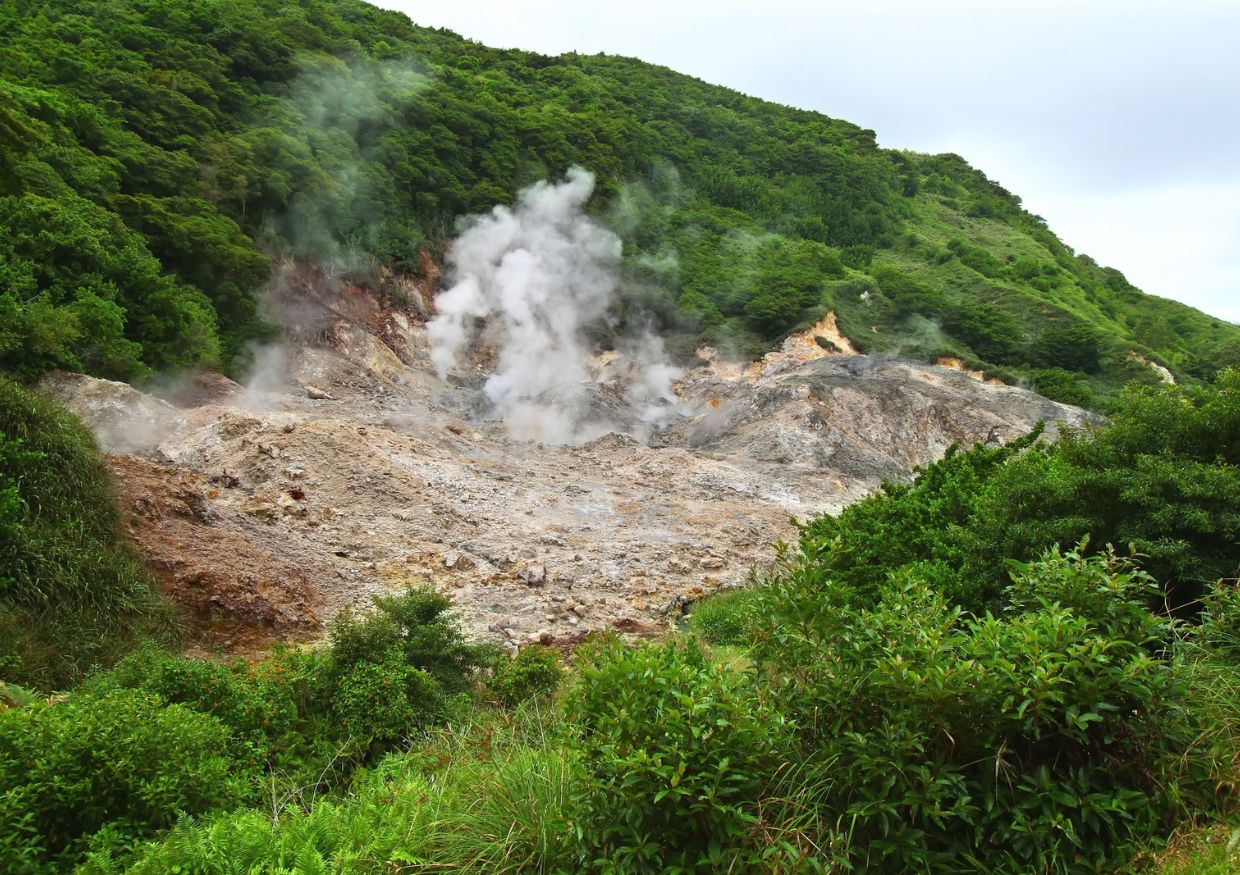Saint Lucia, often referred to as the “Helen of the West Indies” due to its breathtaking beauty, is a Caribbean gem that has captured the hearts of travelers from around the world. While its iconic Piton Mountains, pristine beaches, and vibrant culture are well-known, there are another fun St Lucia facts that often remain hidden from tourists.

Jump to:
- 1) Only Country Named After a Woman
- 2) Two Nobel Laureates
- 3) Unique Flag
- 4) Botanical Gardens
- 5) Saint Lucia Parrot
- 6) Chocolate Heritage
- 7) Pirates and Buccaneers
- 8) Only Drive-In Volcano
- 9) Fishermen’s Ritual
- 10) National Dish
- 11) Independence
- 12) Language Blend
- 13) 7 Types of Dolphins
- 14) National Rainforests
- 15) Banana Industry
1) Only Country Named After a Woman
Saint Lucia is the only country in the world named after a woman. The island was named by French explorers in the 16th century in honor of Saint Lucy of Syracuse, a Christian martyr who is often depicted with a wreath of candles on her head, symbolizing the festival of lights. The island’s stunning natural beauty and lush landscapes certainly make it a fitting namesake for the saint.
2) Two Nobel Laureates
Saint Lucia is the only country in the world with two Nobel laureates. Sir Arthur Lewis received the Nobel Prize in Economics in 1979, and Derek Walcott who won the Nobel Prize in Literature in 1992.
Sir Arthur Lewis
Sir Arthur Lewis was awarded the Nobel Prize in Economics in 1979 for his pioneering work in the field of economics. He made significant contributions to economic development theory, particularly in the areas of economic planning, trade, and industrialization in developing countries. Sir Arthur Lewis was not only the first person of African descent to receive a Nobel Prize in a category other than literature or peace, but he was also the first person from the Caribbean to be honored with this prestigious award.
Derek Walcott
Derek Walcott, a renowned poet and playwright, was awarded the Nobel Prize in Literature in 1992. He was celebrated for his evocative and richly textured poetry, often exploring themes related to Caribbean identity, culture, and history. Derek Walcott’s works, including “Omeros” and “The Star-Apple Kingdom,” have left an indelible mark on the world of literature, and he remains one of the most influential Caribbean writers of his generation.
These two Nobel laureates from Saint Lucia have not only brought international recognition to their homeland but have also made significant contributions to their respective fields, leaving a lasting legacy in the realms of economics and literature.
3) Unique Flag
The Saint Lucian flag features a blue field with a white and yellow diamond in the center. The Cerulean Blue represents the Caribbean Sea and the sky. The yellow symbolizes sunshine and prosperity. The black and white stand for the cultural influences of black and white heritage in Saint Lucia, as well as the harmonious relationship between them.
The flag was adopted on March 1, 1967, when Saint Lucia became an associated state of the United Kingdom. It was slightly modified in 2002.

4) Botanical Gardens
The Saint Lucia Botanical Gardens are situated in the town of Soufrière, which is located on the southwestern coast of Saint Lucia. The gardens are conveniently located near other popular attractions such as the Piton Mountains, Sulphur Springs, and the Caribbean Sea.
The gardens date back to the late 18th century, making them one of the oldest botanical gardens in the Western Hemisphere. They were originally established by the French colonial government in 1785 as a nursery for medicinal plants.
One of the most iconic features of the gardens is the Diamond Waterfall, a mesmerizing 17-meter (56-foot) waterfall that cascades down a mineral-rich cliff face. The minerals in the water give the rocks a colorful appearance, with hues of yellow, green, and brown.

5) Saint Lucia Parrot
The Saint Lucia parrot, scientifically known as Amazona versicolor, is a rare and endangered parrot species native to the Caribbean island of Saint Lucia. This parrot is not only the national bird of Saint Lucia but also one of the most iconic and cherished symbols of the island’s biodiversity and conservation efforts.
The Saint Lucia parrot is a medium-sized parrot, measuring approximately 40 to 45 centimeters (16 to 18 inches) in length. It has striking and vibrant plumage, primarily consisting of shades of green with colorful markings. Its forehead is red, the crown and cheeks are blue, and it has a white eye ring.

The wings are adorned with blue and purple feathers, and the tail feathers are red. The overall combination of colors makes this parrot a visually stunning and distinctive species. The Saint Lucia parrot is listed as critically endangered by the International Union for Conservation of Nature (IUCN). This classification reflects the severe decline in its population and the urgent need for conservation efforts.
The Saint Lucia parrot is not only a symbol of the island’s unique biodiversity but also a source of national pride. It is featured on the country’s official coat of arms and is celebrated during various cultural events and festivals.
6) Chocolate Heritage
Saint Lucia is emerging as a major player in the world of fine chocolate production. The island’s cocoa is celebrated for its quality, and chocolate tours and tastings are a must-try for visitors. This tropical paradise in the Caribbean has made a name for itself in the world of fine chocolate production, and its journey from cacao bean to mouthwatering chocolate bars is a fascinating story.

7) Pirates and Buccaneers
Saint Lucia’s history is intertwined with that of pirates and buccaneers. The island’s coastline provided hiding spots for notorious pirates like François le Clerc and Captain Kidd.
8) Only Drive-In Volcano
Saint Lucia is home to the world’s only drive-in volcano, the Sulphur Springs in Soufrière. Visitors can drive right up to the volcano’s crater and witness its bubbling sulfuric activity.

9) Fishermen’s Ritual
Every year on June 29th, the Feast of Saint Peter, local fishermen in the village of Gros Islet celebrate by holding a colorful and vibrant street party known as the “Fishermen’s Feast.”
10) National Dish
Saint Lucia’s national dish is “green fig and saltfish,” which consists of green bananas (referred to as “green fig”) and salted codfish, typically served with spices and vegetables.
11) Independence
St. Lucia gained independence from Britain on February 22, 1979, and this day is celebrated as a national holiday. The celebration is characterized by various activities including parades, cultural performances, and national ceremonies. These events showcase the rich heritage and culture of Saint Lucia, including traditional music, dance, and cuisine. The day is also a time for reflection on the nation’s history and achievements since gaining independence.
12) Language Blend
Saint Lucia is known for its French-based Creole language, also known as Patois. This language evolved during the French colonial period and is a blend of French and African languages, reflecting the island’s multicultural heritage..
13) 7 Types of Dolphins
One of my favorite St Lucia facts is the 7 types of dolphins that can be seen in the warm waters, including spinner dolphins, bottlenose dolphins and spotted dolphins. You can enjoy watching the dolphins on many tours.
14) National Rainforests
The Saint Lucia National Rain Forest covers about 19,000 acres of the island. This dense rainforest is home to a vast array of flora and fauna, including many endemic species. The forest offers numerous hiking trails for visitors to explore its rich biodiversity.
15) Banana Industry
Once the backbone of Saint Lucia’s economy, the banana industry played a significant role. Although tourism has since overtaken agriculture as the primary economic driver, bananas remain an important export product and part of the island’s cultural identity.

These intriguing facts highlight the rich culture, natural wonders, and unique experiences that await travelers in Saint Lucia. Whether you’re interested in its volcanic marvels, cultural heritage, or culinary delights, Saint Lucia offers a wealth of discoveries for the curious traveler.





Leave a Reply